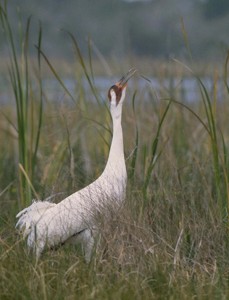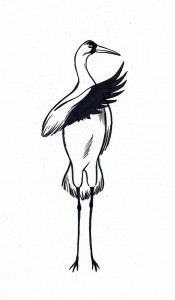Editor’s Note:After three years of waiting, the court has made its decision on the case, “The Aransas
Project vs. Bryan Shaw, et al.” The result is a tremendous victory for endangered whooping cranes and their habitats. In summary, too much fresh water was being removed from upstream sources and whooping crane habitats downstream, on and around the Aranasas National Wildlife Refuge, was being robbed of an equitable share of fresh water. This has had, and is continuing to have, a severe adverse effect on whooping cranes.After reading the “Introduction” and the “Memorandum Opinion and Verdict of the Court”, we decided to post it here verbatim because it is written in such a clear and concice manner. And you will have the facts as the court had written them. For those wanting to read the entire court decision, click on: http://thearansasproject.org/wp-content/uploads/2013/03/TAP-Opinion.pdf
UNITED STATES DISTRICT COURT, SOUTHERN DISTRICT OF TEXAS,CORPUS CHRISTI DIVISIONTHE ARANSAS PROJECT, Plaintiff, VS. BRYAN SHAW, et al., Defendants.
INTRODUCTION.
In the annals of conservation, the return of the Whooping Crane from the brink of extinction is one of the most fabled stories. In the 1940’s, less than fifteen of these remarkable birds – the tallest in North America and the rarest species of crane in the world – remained. With the creation of wildlife refuges and other conservation efforts, the population of the birds has slowly risen to, including both those in captivity and those not in captivity, to around 500 birds. At issue here is the threat of extinction to the non-captivity population of around 300. However, the “whoopers” are still at risk, as development and environmental issues continue to threaten their habitat.
This case concerns the world’s only self-sustaining, wild Whooping Crane population, known as the “AWB” flock, and its winter home in South Texas at the Aransas National Wildlife Refuge (the “Refuge”), and surrounding estuarine areas that comprise the AWB cranes’ critical winter habitat. The AWB cranes normally begin to arrive at their winter habitat in late October, and depart in early April of the following year.
The Aransas Refuge is located midway along the Texas Gulf coast, about 140 miles southof Houston and 50 miles north of Corpus Christi. The cranes’ wintering grounds are comprisedof approximately 9,000 hectares of salt flats on the Refuge itself and also on adjacent islands,including the Blackjack Peninsula, San Jose Island, and Matagorda Island.
The area is bordered on the east by the Gulf of Mexico, receiving daily impulses of salt water with the changing of the tides. The Refuge receives freshwater inflows from primarily two river sources, the San Antonio and the Guadalupe, each located to the north and slightly west of the area.
The San Antonio river flows into the Guadalupe river system, and the Guadalupe river flows directly into the Refuge, emptying into the San Antonio bay. The area where the freshwater enters the Refuge is referred to correctly as the “Guadalupe estuary,” but it is known also as the “San Antonio bay.” The San Antonio and the Guadalupe river systems emerge from underground springs near San Antonio and run 250 miles southeast where they join together just before entering the San Antonio bay and flow into the AWB flock’s winter habitat, that extends slightly north of the Refuge.
These freshwater inflows come from a combination of spring flows and rainfall. Whooping Cranes face extinction. Indeed today, it is estimated that only 500 Whooping Cranes exist worldwide. In 1967, the United States listed the Whooping Crane as threatened with extinction, 32 Fed. Reg. 4001 (Mar. 11, 1967), and in 1970, they were listed as endangered 35 Fed. Reg. 16047 (Oct. 13, 1970). In 1973, both of these classifications were “grandfathered” into the Endangered Species Act. 16 U.S.C. § 1531, et seq., 87 Stat. 884.
Beginning in 1950, the United States Fish & Wildlife Service (USFWS) employed aerial surveys to provide an annual census of how many AWB cranes arrived at the Refuge in the fall, and how many departed in the spring. Mr. Tom Stehn, a USFWS biologist, worked at the Refuge for over 29 years, and personally developed and implemented a method to count the individual birds of the AWB flock utilizing the cranes’ well-documented behaviors of site fidelity, site tenacity, and crane territoriality.0 Because specific birds returned to their specific locations, Mr. Stehn was able to map their territories and to confirm their presence or absence with weekly aerial surveys. Based on his intimate knowledge of the AWB crane and his mapping of their territories, Mr. Stehn concluded that, at the start of the 2008 winter season, the AWB flock had grown to its peak number of 270 birds, plus or minus 2 to 3 percent.
During the 2008-2009 winter, there was a severe drought. As the winter progressed, the AWB cranes began to demonstrate unusual behavior. For example, parents would deny their juveniles food, and the birds began venturing out of their specific territories in search of food and fresh water. When the cranes first arrive at the Refuge, it is normal for the parents to feed the juvenile. The juveniles’ beaks are soft and tender, and it is necessary for the parent to break the shell and feed the crab to the begging juvenile. As the winter progresses, the parent pulls the crab from the water, kills it, and leaves it for the juvenile. During the 2008-2009 winter, Dr. Chavez Ramirez observed a parent aggressively pushing his juvenile away from a crab that had been caught. He had never seen a parent deny food to a begging juvenile. Such behavior indicates that the parent was under food stress. The birds’ behavior was so alarming that Mr. Stehn contacted Dr. Chavez-Ramirez, a biologist with two decades of field research on the AWB cranes and a member of the International Whooping Crane Recovery Team, and asked him to visit the Refuge and observe the cranes. Dr. Chavez-Ramirez was equally troubled and concerned with his observations of the cranes’ behavior. Both he and Mr. Stehn observed that the lack of freshwater inflows had increased salinities across the Refuge. These hyper-saline conditions, verified by field measurements, led to a decrease in blue crabs and wolfberries, the staple diet of the AWB flock. This food shortage led to bird emaciation, stress behavior, and an over-all decline in bird health. That is, without proper freshwater inflows, the AWB’s critical habitat had been thrown out of balance, with ramifications up and down the food chain. That winter, at least 23 AWB cranes, or 8.5 % of the AWB flock, died at the Refuge. Another 34 birds that left Texas in spring, failed to return in fall.
After news of the high crane mortality in the 2008-2009 winter became known, certain environmentalists, local coastal business owners, bird enthusiasts, and others formed “The Aransas Project,” (“TAP”), a Texas nonprofit corporation. The TAP members have a direct interest in the AWB Whooping Cranes and the ecological health of the San Antonio, Carlos, Mesquite, and Aransas bays that connect to the Refuge.
The State of Texas owns its surface water, and this includes the water in the Guadalupe and the San Antonio River systems. Under Texas law, freshwater capture and use is regulated by the Texas Commission on Environmental Quality (TCEQ), a State agency. Through its permit process and regulatory powers, the TCEQ can affect the availability of freshwater to users along the river system.
Prior to filing this lawsuit, TAP petitioned the TCEQ for a water permit to require a certain amount of freshwater to remain instream in the Guadalupe and San Antonio river systems to ensure that sufficient amounts of freshwater reached the Refuge and surrounding areas adjacent to the San Antonio bay that comprise the critical habitat of the AWB cranes. TAP’s permit request was denied, and on December 7, 2009, TAP gave notice of its intent to sue.
On March 10, 2010, TAP filed this lawsuit alleging that the TCEQ defendants had violated Section 9 of the Endangered Species Act (ESA), 16 U.S. C. § 1531 et seq., by failing to properly manage freshwater inflows into the San Antonio and Guadalupe bays during the 2008-2009 winter, causing an unlawful “take” of AWB cranes. (D.E. 1). TAP maintains that the TCEQ defendants’ water management practices during 2008-2009, combined with the severe drought, drastically modified the AWB cranes’ critical habitat making it hyper-saline. In turn, the hyper-saline conditions caused a reduction in the availability of wolfberries and blue crabs, the cranes’ primary food resources, as well as in fresh drinking water. The lack of food and freshwater caused the cranes to become emaciated and to engage in stress behavior. Emaciation led to increased illness and disease susceptibility, and the cranes’ unusual stress behaviors including leaving the safety of their site territories, contributed to increased predation. In total, the adverse modification of the cranes’ critical habitat effectively caused the death of at least 23 Whooping Cranes that winter season, constituting a “take” under the ESA.
MEMORANDUM OPINION AND VERDICT OF THE COURT
Thus, it is therefore DECLARED that:
(1) The TCEQ, its Chairman, and its Executive Director have violated section 9 of the ESA, and continue to do so through their water management practices which include the decision to not monitor D&L users or to exercise emergency powers available to protect the endangered whooping cranes; and
(2) Texas water diversion regulations promulgated by the TCEQ, its Chairman, its Executive Director, and the Texas legislature are preempted by federal law when they purport to authorize water diversions that result in a taking of whooping cranes.
Therefore, it is ORDERED that:
(1) The TCEQ, its Chairman, and its Executive Director are enjoined from approving or granting new water permits affecting the Guadalupe or San Antonio Rivers until the State of Texas provides reasonable assurances to the Court that such permits will not take Whooping Cranes in violation of the ESA.
(2) Within thirty (30) days of the date of entry of this Order, the TCEQ, its Chairman, and its Executive Director shall seek an Incidental Take Permit that will lead to development of a Habitat Conservation Plan. See 16 U.S.C. § 1539(a); 50 C.F.R. § 17.22(b) (listing requirements for an Incidental Take Permit)
The Court will retain jurisdiction over this action during the formulation of the HCP process. The Court finds that Plaintiff TAP is the prevailing party in this matter, and is entitled to an award of its reasonable attorney’s fees and costs, as well as expert witness fees, incurred in this action. See 16 U.S.C. § 1540(g)(4).
SIGNED and ORDERED this 11th day of March, 2013. Janis Graham Jack Senior United States District Judge
The Whooping Crane Conservation Association appreciates the decision made by U.S. District Judge Janis Graham Jack and the work of James Blackburn, everyone on The Aransas Project team, Tom Stehn and other private citizens who made our voices heard! This is a tremendous decision in favor of endangered whooping cranes and other wildlife along the Texas coast that need and deserve their share of fresh water.



